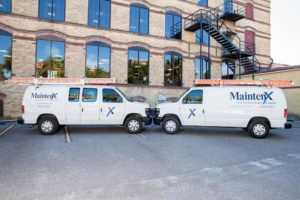LED lighting upgrades have become a prevalent topic among busy facility managers and company owners looking to reduce operating and maintenance costs. Besides the reduced month-after-month energy usage, LED light bulbs can last up to 100,00 hours, further reducing maintenance costs.
The LED Story
Many assume that LED lights are a relatively new product, but the green LED debuted in 1958. The red LED came about in 1962, and by 1964 the new lighting option was embraced by the engineers and researchers at IBM for building circuit boards for early computers. Finally, in the 1980s, the first generation of super-bright yellow, green, and red LED lights became available.
However, the first LED light bulbs for commercial and residential fixtures didn’t hit the market until the fall 1996. Since LED lights do not produce white light alone, they require one of two whitening techniques as part of the manufacturing process.
- Use a blue LED with a phosphor coating to convert blue light to white.
- Combining red, blue, and green chips at varying intensities to produce a white light.
Today’s LED light bulbs have various screw-in bases that work with your existing incandescent and fluorescent bulb fixtures. And plug-and-play LED tubes are readily available in standard lengths for your existing T8 (1” diameter) and T12 (1.5” diameter) fluorescent light bulbs.
While fluorescent is vastly superior to incandescent light bulbs, both compact fluorescent lamps (CFLs) and linear fluorescent lamps (LFLs) raise environmental concerns since every fluorescent light bulb contains a small amount of mercury.
LED outperforms traditional lighting options
The chart below compares the energy usage and lifecycles of the three most popular lighting options available today.
| Light type | Annual usage | Typical lifecycle |
| Incandescent | 3285KWh/year | 1,000 hours |
| Fluorescent | 767KWh/year | 7,000 – 15,000 hours |
| LED | 329KWh/year | 100,000 – 250,000 hours |
While there are several ways to dissect and interpret this data, it’s evident that an LED lighting upgrade could reduce your lighting costs by up to 90% month after month compared to incandescent lights and nearly 50% compared to fluorescent lights.
When comparing longevity, one LED light eliminates purchasing and storage concerns for 100+ incandescent or 8-15 fluorescent bulbs. In addition to lower inventory costs, your facilities team can attend to other maintenance tasks or projects instead of consistently changing out light bulbs.
It’s no secret that incandescent bulbs are the least-efficient lighting option for companies like yours. However, last year, the Department of Energy issued a new ruling requiring all light bulbs to meet new energy-efficient standards by July 31, 2023. As a result, the incandescent bulbs (and some halogen options) used by many homes and businesses will no longer be available once current inventories have sold out.
This action leaves business owners with two lighting options. And while LED lighting will save on energy and maintenance costs, you’re probably wondering if an LED lighting upgrade has any other advantages.
Fluorescent lights emit UV light, which wastes energy and is responsible for eye strain and the fading of particular finishes, including paint, fabric, and carpeting. All LED light transmission occurs in the visible light range without any harmful UV side effects.
Their solid-state design makes LED lights more rugged than their fragile fluorescent counterparts, resulting in less transit and storage damage. And unlike their fluorescent counterparts, they are 100% mercury-free, simplifying the recycling process.
Fluorescent lights are not directional, meaning they radiate light in a 360° pattern around the exterior of the tube or bulb. As a result, only a tiny amount of light gets directed to the desk or workstation below. While deflectors can control more of the light toward the desired area, most remain scattered and unfocused.
In comparison, most LED light radiates outward in a 110° arc, directing most of the light to the desired surface or area. The result is a substantially brighter and safer workspace without light deflectors or diffusers.
Fluorescent light bulbs can produce 50-100 lumens per watt, while LEDs produce 130 lumens per watt. And LED lights convert 95% of their energy to light and 5% to heat, while fluorescent lights can release up to 20% of their power to light and lose the remaining 80% to heat.
Regardless of industry or company size, an LED lighting upgrade will reduce energy and maintenance costs. Lower operating costs translate directly into higher productivity and profit margins.
In addition to lower costs and increased longevity, an LED lighting upgrade may be eligible for rebates from energy providers and tax credits from the federal government.
If you want to discuss the benefits of an LED lighting upgrade for your business in greater detail, the MaintenX Electrical Team can answer your questions or provide a quote to handle the entire LED upgrade process.


